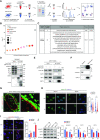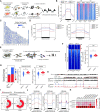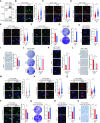SIRT3 consolidates heterochromatin and counteracts senescence
- PMID: 33706382
- PMCID: PMC8096253
- DOI: 10.1093/nar/gkab161
SIRT3 consolidates heterochromatin and counteracts senescence
Erratum in
-
Correction to 'SIRT3 consolidates heterochromatin and counteracts senescence'.Nucleic Acids Res. 2021 Sep 7;49(15):9004-9006. doi: 10.1093/nar/gkab698. Nucleic Acids Res. 2021. PMID: 34370038 Free PMC article. No abstract available.
Abstract
Sirtuin 3 (SIRT3) is an NAD+-dependent deacetylase linked to a broad range of physiological and pathological processes, including aging and aging-related diseases. However, the role of SIRT3 in regulating human stem cell homeostasis remains unclear. Here we found that SIRT3 expression was downregulated in senescent human mesenchymal stem cells (hMSCs). CRISPR/Cas9-mediated depletion of SIRT3 led to compromised nuclear integrity, loss of heterochromatin and accelerated senescence in hMSCs. Further analysis indicated that SIRT3 interacted with nuclear envelope proteins and heterochromatin-associated proteins. SIRT3 deficiency resulted in the detachment of genomic lamina-associated domains (LADs) from the nuclear lamina, increased chromatin accessibility and aberrant repetitive sequence transcription. The re-introduction of SIRT3 rescued the disorganized heterochromatin and the senescence phenotypes. Taken together, our study reveals a novel role for SIRT3 in stabilizing heterochromatin and counteracting hMSC senescence, providing new potential therapeutic targets to ameliorate aging-related diseases.
© The Author(s) 2021. Published by Oxford University Press on behalf of Nucleic Acids Research.
Figures





Similar articles
-
ZKSCAN3 counteracts cellular senescence by stabilizing heterochromatin.Nucleic Acids Res. 2020 Jun 19;48(11):6001-6018. doi: 10.1093/nar/gkaa425. Nucleic Acids Res. 2020. PMID: 32427330 Free PMC article.
-
S-sulfhydration of SIRT3 combats BMSC senescence and ameliorates osteoporosis via stabilizing heterochromatic and mitochondrial homeostasis.Pharmacol Res. 2023 Jun;192:106788. doi: 10.1016/j.phrs.2023.106788. Epub 2023 May 3. Pharmacol Res. 2023. PMID: 37146925
-
Stabilization of heterochromatin by CLOCK promotes stem cell rejuvenation and cartilage regeneration.Cell Res. 2021 Feb;31(2):187-205. doi: 10.1038/s41422-020-0385-7. Epub 2020 Jul 31. Cell Res. 2021. PMID: 32737416 Free PMC article.
-
Restructuring of Lamina-Associated Domains in Senescence and Cancer.Cells. 2022 Jun 5;11(11):1846. doi: 10.3390/cells11111846. Cells. 2022. PMID: 35681541 Free PMC article. Review.
-
The Role of SIRT3 in the Osteoporosis.Front Endocrinol (Lausanne). 2022 May 25;13:893678. doi: 10.3389/fendo.2022.893678. eCollection 2022. Front Endocrinol (Lausanne). 2022. PMID: 35692409 Free PMC article. Review.
Cited by
-
Role of SIRT3 in bone homeostasis and its application in preventing and treating bone diseases.Front Pharmacol. 2023 Dec 20;14:1248507. doi: 10.3389/fphar.2023.1248507. eCollection 2023. Front Pharmacol. 2023. PMID: 38192409 Free PMC article. Review.
-
Sirtuin 1/sirtuin 3 are robust lysine delactylases and sirtuin 1-mediated delactylation regulates glycolysis.iScience. 2024 Sep 10;27(10):110911. doi: 10.1016/j.isci.2024.110911. eCollection 2024 Oct 18. iScience. 2024. PMID: 39351192 Free PMC article.
-
Rejuvenation of Tissue Stem Cells by Intrinsic and Extrinsic Factors.Stem Cells Transl Med. 2022 Mar 31;11(3):231-238. doi: 10.1093/stcltm/szab012. Stem Cells Transl Med. 2022. PMID: 35303745 Free PMC article.
-
Deacetylation of FOXP1 by HDAC7 potentiates self-renewal of mesenchymal stem cells.Stem Cell Res Ther. 2023 Jul 28;14(1):188. doi: 10.1186/s13287-023-03376-7. Stem Cell Res Ther. 2023. PMID: 37507770 Free PMC article.
-
IFN-Aging: Coupling Aging With Interferon Response.Front Aging. 2022 May 2;3:870489. doi: 10.3389/fragi.2022.870489. eCollection 2022. Front Aging. 2022. PMID: 35821859 Free PMC article. Review.
References
Publication types
MeSH terms
Substances
LinkOut - more resources
Full Text Sources
Other Literature Sources
Medical
Molecular Biology Databases
Research Materials

